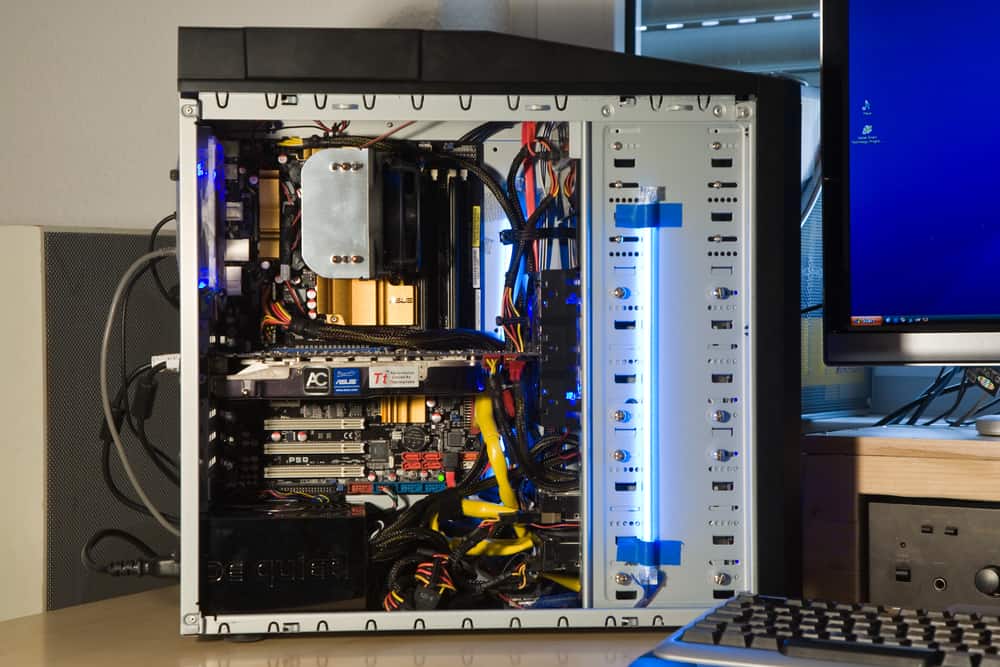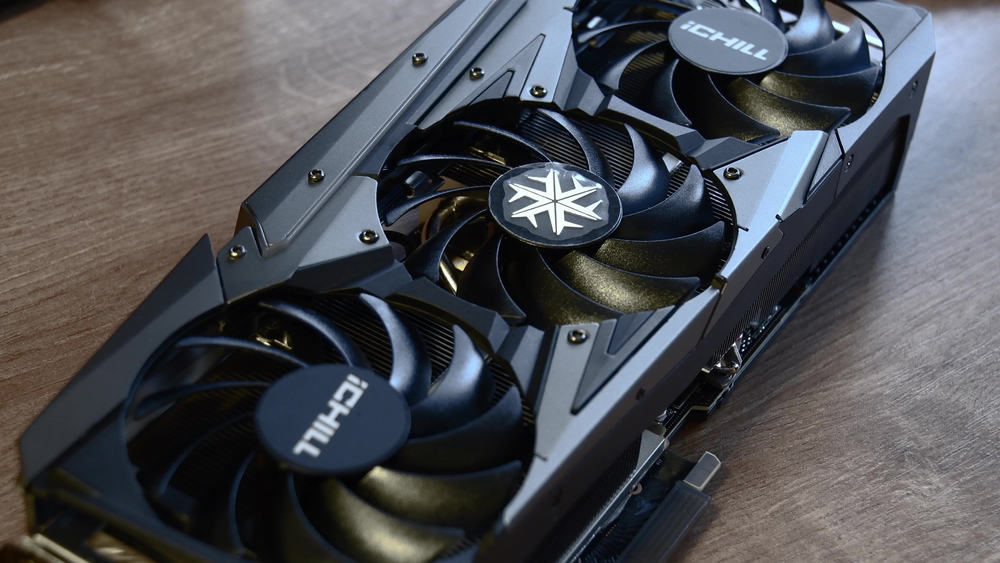
You have decided to invest in a new GPU and start researching brands and prices.
As you look, you discover that not only are GPUs hard to find in stock, but the prices are exorbitant!
Why are GPU prices so high?
It boils down to the law of supply and demand which has been affected by numerous variables.
Why Are GPU Prices So High? (Top 10 Reasons)
1. Semiconductor Chip Shortage

Semiconductors are used in all computerized devices as well as all devices that use radio waves.
When the pandemic hit, automobile manufacturers, expecting a reduction in demand for vehicles, reduced the number of orders for semiconductors which led to a reduction in production.
Also, lockdowns and quarantines reduced the production of semiconductors due to a shortage of available workers.
To exacerbate the issue, as the pandemic wore on, demand for electronic devices increased, leading to an increase in the demand for semiconductors.
As stock ran out, a backlog of orders developed, and while production of semiconductors has resumed, the backlog and demand still exceed production.
2. COVID-19

Covid-19 has been a factor in the rise in prices of just about everything, and GPUs have been affected as well.
The pandemic has pushed more people to work from home as well as to find new ways to entertain themselves.
This shift in the work and home environments has led to increased demand for computing technology including PCs, tablets, and laptops.
These devices require GPUs.
Users who have become dependent on personal devices are also exploring ways to enhance their current equipment to deliver the quickest and most efficient computing device, which leads to an increase in GPU demand.
The Covid pandemic has also led to shipping issues.
Lockdowns and quarantines have limited the number of imports and exports coming in and out of some countries.
Quarantines have also produced labor shortages which have affected shipping lines and methods.
With the reduction in shipping and imports and exports, necessities have been given priority over luxury goods such as GPUs, leading to a shortage of GPUs.
3. Cryptocurrency

Cryptocurrencies such as Bitcoin and Ethereum have become more mainstream and accepted in the last few years.
Cryptocurrency is dependent on cryptocurrency miners to validate transactions.
With this increase in demand, more people are mining cryptocurrency themselves for profit.
The problem with this shift is that mining cryptocurrencies demand an abundance of computing power, computing power provided by GPUs.
Large cryptocurrency mining operations can use thousands of GPUs at once.
4. Blockchains

It is well known that cryptocurrency is based on blockchain technology.
However, as technology advances and consumers are demanding more efficient and visible transactions, other businesses are embracing blockchain technology.
Blockchains are now used in everything from finance and mortgages to records and materials tracking.
An increase in the use of blockchain technology leads to an increase in the demand for GPUs capable of handling and validating transactions.
5. Higher Quality

Just as with all things technical, GPUs are experiencing increased performance and capabilities to meet and exceed demand.
GPUs are being packed with increased storage, compatibility, and power.
This increase in capabilities has led to a higher demand for newer GPUs packed with all of the goodies that all users, not just gamers and media professionals, want.
6. Tariffs

Tariffs on products imported from China were raised to 25% in 2018.
This increase in tariffs affected many products including technology products such as semiconductors.
Semiconductors are needed, of course, to make products like GPUs.
As the cost of importing products from China increases, the cost to produce items that use those imported goods also increases.
This increase in production cost is passed on to the consumer in the form of higher prices.
7. Cost Of Shipping

Linked to the increase in tariffs on Chinese products, the cost of shipping has also increased.
With fewer products coming from China, it becomes less cost-efficient to send container ships that are not full of products across the ocean.
The ones that do make the trip have to increase shipping charges to make up for the reduction in products.
Increased shipping costs have also hit the air freight industry.
While there are air freight shipping methods dedicated simply to shipping, a significant amount of freight travels in passenger planes.
With the reduction in personal travel, the amount of freight being shipped via that method has also reduced, increasing shipping costs.
8. Bundling

The demand for GPUs is so significant that some manufacturers of GPUs who also produce other technology products such as CPUs will require a purchase of the less demanded product to receive the high demand GPU.
This results in retailers not wanting to be hampered with a product they cannot move to receive the in-demand GPU.
9. Entertainment

Gaming demands high-quality GPUs.
As the demand for more advanced gaming experiences increases, the need for high-quality GPUs also increases.
This demand extends beyond gaming, though.
There has been an increase in demand for high-quality animation, video editing, and computer graphics to meet entertainment needs.
Demand for high-quality streaming content is also on the rise, requiring more advanced GPUs to meet the needs of the entertainment industry.
10. Scalpers

Savvy scalpers and resellers have jumped on the increased demand for GPUs.
Resellers will employ the use of bots to purchase stock the second it becomes available.
They will then resell those items on resell platforms for exorbitant prices.
To exacerbate the issue, consumer demand is so high that buyers will pay the high prices to receive the item, motivating scalpers and resellers to continue to deplete stock and resell for personal gain.
Will GPU Prices Return To Normal?

The factors contributing to the massive increase in the cost of GPUs are not likely to disappear anytime soon.
However, GPU producers such as Nvidia and AMD are set to launch their next-generation cards in the fall.
This may help stabilize GPU prices.
Also, as the demand for more power-friendly methods of cryptocurrency mining increases, the incentive is out for technological innovations which will reduce the amount of processing power needed to mine cryptos.
This might also reduce the demand for GPUs.
Unfortunately, none of this will affect the current GPU cost environment any time soon.
How To Install A New GPU

If you are looking for and lucky enough to find a GPU at an affordable price, you will find these installation instructions helpful.
1. Check Compatibility
The first step before you buy or install a new GPU is to make sure the one you choose is compatible with your current setup.
GPUs on the market today require a PCI-Express slot for connection.
Also, make sure that the power supply available on your device can manage the additional power draw from the new GPU.
Look at the available space inside of the tower housing.
Most full-size towers will be able to accommodate any new GPU, but mid-size or smaller towers may not.
If you find that your new GPU will not fit into the housing, external cases are available but may limit some of the performance as well as require an additional power source.
2. Turn Everything Off
Power down your entire setup.
The disconnect all cables to free the tower.
3. Remove external cover
The side panel of the tower is typically held in place by two screws.
Remove the screws to expose the interior of the PC.
4. Locate The Old GPU
(If you do not have a separate GPU, skip to step 8.)
Locate the GPU in the PCI-express slot.
GPUs typically have a fan on them, making them easily recognizable.
5. Remove GPU Screws
Remove the screw or screws holding the GPU to the housing and place the screws in a safe place for use later.
6. Disconnect The GPU Power (If It Has One)
See if the GPU has a separate power connection.
This will be a black plug with numerous little boxes.
If it does, unplug it.
7. Remove The Old GPU
Release the GPU from the PCI-E slot by locating the tab at the base of the GPU.
Depending on the computer, you will either push the tab down or to the side to release the old GPU.
Once released, you should be able to gently pull the GPU out of the slot.
DO NOT FORCEFULLY REMOVE THE GPU.
8. Locate The PCI-E X 16 Slot
If you just removed an old GPU, then you know where the slot is.
If you are installing a GPU for the first time, locate the PCI-E x 16 slot.
It should be covered with a black blank insert and most likely held in place by screws.
Remove the screws and place them in a safe place.
You will need them later.
Remove this insert.
You may need to remove inserts from two slots if the GPU you bought is a double card.
9. Insert The New GPU
Make sure the GPU is oriented correctly with the PCI-E slot.
Gently insert the new GPU until the GPU tab clicks into place.
Replace the previously removed screws to anchor the card to the housing.
10. Plug In The Power Connection (If It Has One)
Locate the power plug on the GPU and insert it into the corresponding power slot, typically a 6 or 8 pin VGA slot.
11. Double-Check Connections
Double-check all the connections.
Make sure the PCI-E slot tab has been clicked into place.
Check to see if the power cable has been inserted fully.
Check all screws for secure connection.
12. Replace The Side Panel
Replace the side panel which you removed at the beginning.
Screw the previously removed screws to secure the panel.
13. Plug The Pc In And Start It Up
Replace all of the previously removed cords and cables and power up the device.
Make sure you connect the monitor to the correct port on the GPU.
If you plug the monitor into the CPU, you will be using the built-in GPU in the CPU.
If the screen is black, recheck all connections.
The most common problem with a GPU install is the GPU does not get seated into the PCI-E slot correctly.
14. Install Drivers
You will need to install the appropriate drivers for the new GPU.
While the picture will display as soon as you turn on the device, the GPU will not run to its full potential until the correct drivers are installed.
Look on the manufacturer’s website for the download corresponding to your product.
Download the appropriate driver based on your operating system and the purchased GPU.
This may take a few minutes due to the size of most GPU drivers.
15. Enjoy!
What Is A GPU?

The graphics processing unit, or GPU, was originally designed for rendering 3D graphics.
As time passed, the capabilities of GPUs were used for more applications than just graphics rendering.
The GPU acts as a parallel processor in conjunction with the CPU to produce visual displays.
The power of GPUs is now being harnessed for high-performance computing, artificial intelligence, deep learning, video editing, and content creation.
GPUs also supply the main computational power behind cryptocurrency mining, such as Bitcoin and Ethereum, due to their ability to produce repetitive work efficiently.
What Is A Driver?

A graphics driver is the software that allows the GPU to communicate with the operating system.
Each GPU has a specific driver released by the manufacturer of the GPU.
Go directly to the manufacturer’s website to install the graphic driver.
This is also where you will find updates for your specific GPU.
IT is essential to keep your driver updated.
Updates protect against known vulnerabilities and bugs within the GPU system.
GPU Vs. Graphics Card

A GPU and a graphics card are two distinct pieces of hardware.
The GPU is just the graphics processing unit that can be integrated or discrete.
The graphics card, however, is a separate board that has a GPU chip on it.
All graphics cards have GPUs, but not all GPUs are on a graphics card.
Integrated GPU
An integrated GPU is embedded beside the motherboard.
This allows for a more streamlined housing, lower power consumption, and reduced cost.
Many devices sold today come with a highly capable integrated GPU.
Discrete GPU
A discrete GPU is a separate chip, that is housed on its own circuit board, often called the graphics card.
The chip is usually plugged into the motherboard via a PCI Express slot.
A discrete GPU is ideal for more demanding processes and boosts performance as well as power consumption and heat generation.
What Is A Semiconductor?

A semiconductor is a device that has more conductivity than an insulator but less conductivity than a pure conductor, hence the term semiconductor.
Semiconductors are created by doping an insulator, such as silicon.
The most common forms of semiconductors are diodes and transistors.
What Is Doping?
Doping is the process of adding an impurity to an insulator like silicon to create a semi-conductive substance.
There are two types of doping, N-type and P-type.
With N-type doping, a small amount of phosphorus or arsenic is added to the silicon to create a negative charge.
P-type doping adds boron and gallium to the silicon to create a positive charge.
What Is A Diode?
When an N-type and P-type piece of silicon are put together, they create a diode.
A diode is the simplest form of semiconductor and allows for an electrical current to run in one direction only, like the concept of a push door.
You can push from one side to open the door, but if you push from the other side, you can no longer open the door.
Diodes can be used to convert AC to DC, as electrical switches and as electrical current blockers.
What Is A Transistor?
A transistor, unlike a diode, is a layer of three charged silicone components.
The components are layered in either an NPN or PNP configuration, depending on the application.
The addition of the middle layer between two like components allows for a small electrical charge to be passed between the top and bottom layer to create a switching effect.
This switching effect forms the basis of Boolean logic gates, which is how the computer understands binary.
Thousands of transistors are placed together on a silicon ship to create a microprocessor.
References:
“What Is a GPU? Graphics Processing Units Defined.” Intel, https://www.intel.com/content/www/us/en/products/docs/processors/what-is-a-gpu.html. Accessed 10 Feb. 2022.
“How Semiconductors Work.” HowStuffWorks, 25 Apr. 2001, https://electronics.howstuffworks.com/diode.htm.
Luebke, David. “How GPUs Work.” How Things Work: Nvidia Research, pp. 96–100, https://research.nvidia.com/sites/default/files/pubs/2007-02_How-GPUs-Work/04085637.pdf. Accessed 9 Feb. 2022.
“Why Graphics Cards Cost so Much Right Now.” PCWorld, https://www.pcworld.com/article/394292/a-perfect-storm-why-graphics-cards-cost-so-much-now.html. Accessed 7 Feb. 2022.
NEXT: Do You Need A Monitor For A PC? (Everything To Know)
























